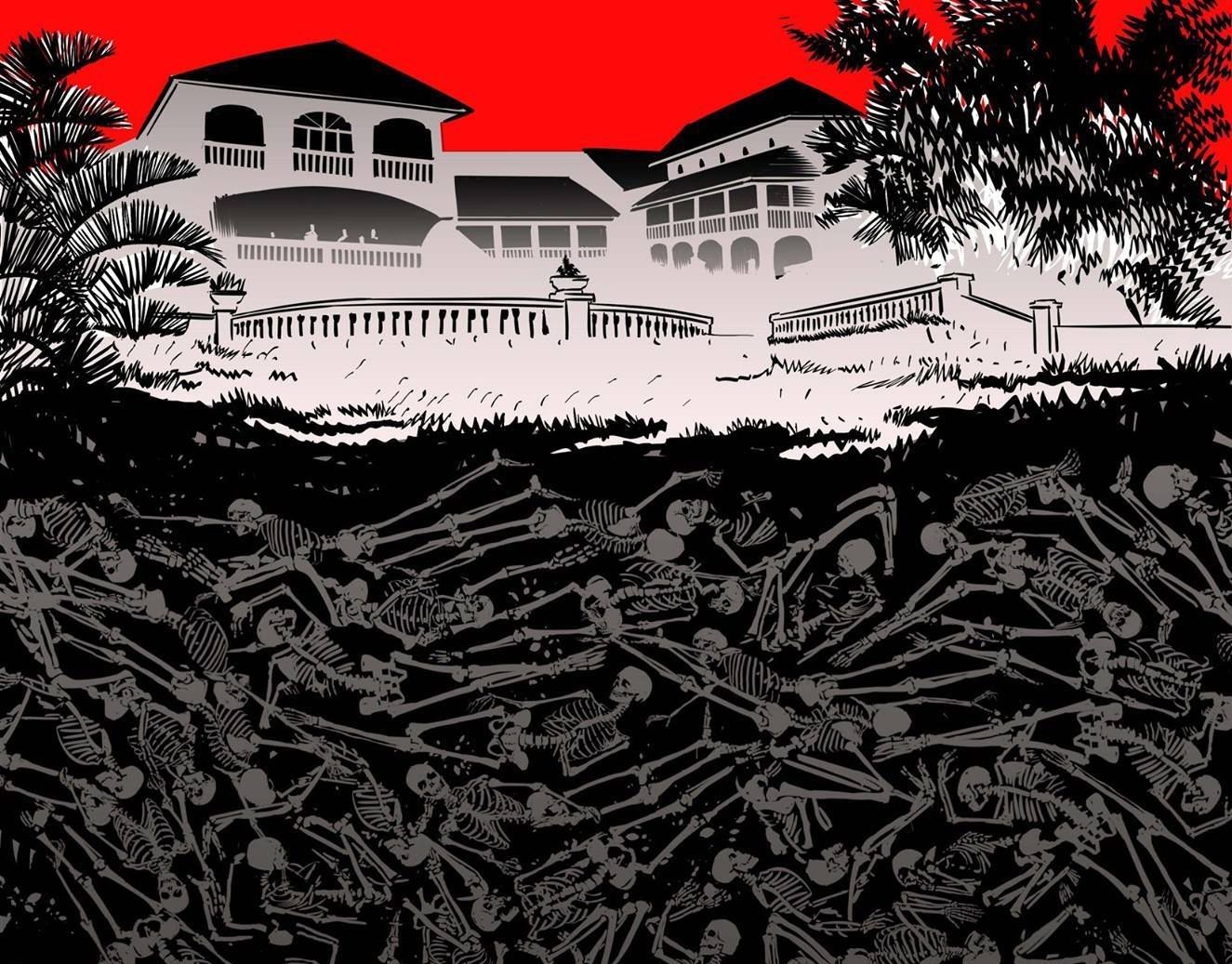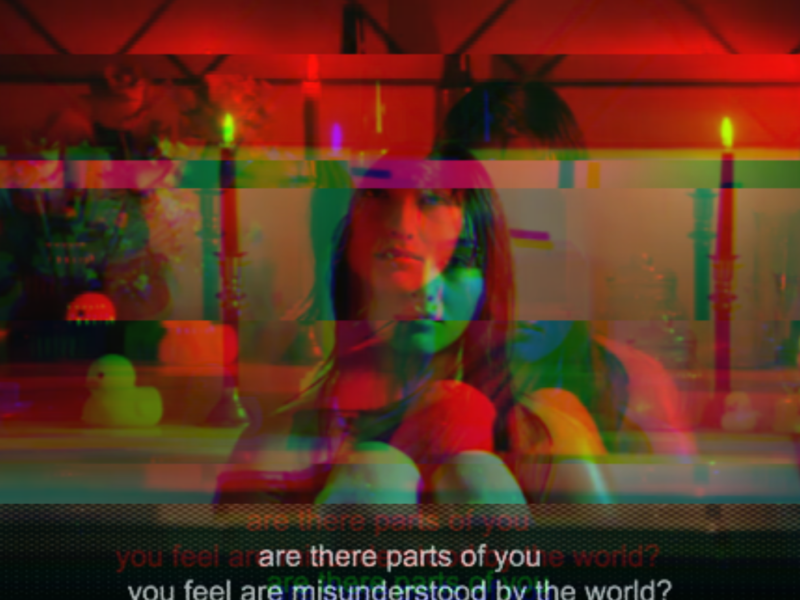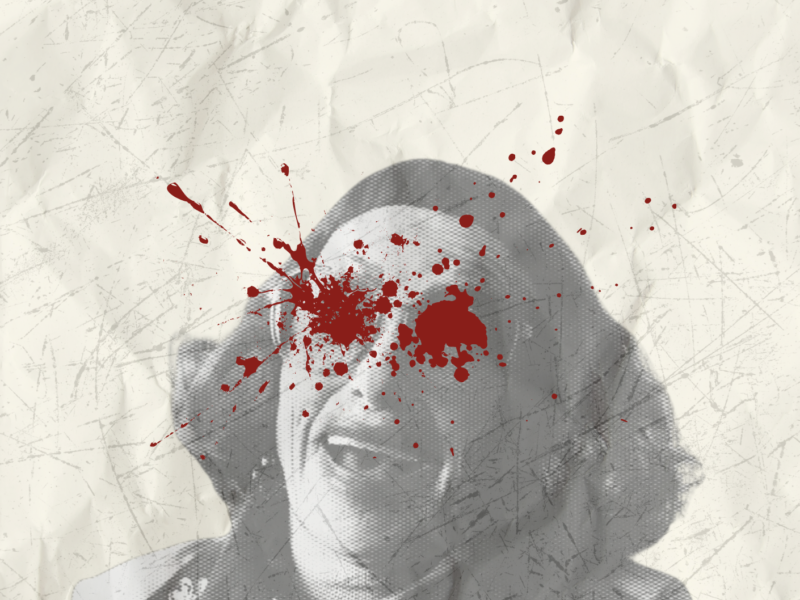After the English translation of the popular “Patay Kung Patay” zombie comic book series won big at the 41st Philippine National Book Awards, its creators talk about how it was made and the other forms it could take in the future.
The creators of “Patay Kung Patay” (PKP,) a Filipino comic book series about a zombies attacking a hacienda, recently breathed new life back into the project.
Originally in Filipino, the new English-translated collected issues version of the story titled Death Be Damned won big at the 41st Philippine National Book Awards. It was feted as the “Best Book of Graphic Novel and Comics in English.” The citation from the awards body declared it “a pageant of blood and the absurd,” and, having collected and read the original eight issues of the Filipino version, I am inclined to agree.
Combining a zombie milieu set against a feudal style yet already modern hacienda, PKP features a trio of showbiz reporters working under a big network. They gate crash a party of elite landowners (the Muguerza family) and their sycophants, celebrating the eve of a landmark business merger at their country mansion.
Unfortunately, it’s on the same day that the dead rise again under the command of a 12-year old hero, someone bent on exacting the vengeance her family—the Sakays, tillers of the land—seek. Mayhem and farce ensue as the reporters are caught between zombies and heavily armed bourgeoisie. The story revolves around their attempt to get out with their heads intact—or at least with the story of their careers.
“I just wanted a good revenge story and lots of dead bodies,” said Mike Alcazaren its creator
whose day job is that of a commercial film and TV director. He got his wish when he teamed up with the powerhouse script and drawing team of AJ Bernardo, Josel Nicolas, and Noel Pascual back in 2015. The series was a success.
PKP, at least from the original Filipin0-language issues I possess, shines as a satire of our strange, silly and magic realist classist society with its gorgeous art and supernatural mockery of how Pinoy land reform and ownership operates. It’s not perfect. Some characterizations might clearly be better developed (especially in an ensemble setting.) And, the transitions and flow of the visuals through the panels are sometimes brought down by lack of clarity. Definitely could have been made better through more critical planning.
Overall, however, the strength of the funny and bloody tone, plus the enjoyment of seeing popular figures dismembered, shot, or devoured is the kind of joy no Pinoy able to read should miss—even if you’re not a horror comics fan.
While I prefer the original language version, the English trade paperback is a welcome addition to the intrinsically Filipino cultural delights that PKP can offer to an international readership.
“There were four of us who worked our asses off for over seven years, so it feels good to be validated,” said Bernardo about their win at the NBA.
“Well, it still is surreal!” exclaimed Alcazaren. “I don’t think it has sunk in up to now.”
“It was such an honor to win at the NBA as it felt like a validation of our efforts in making sure the English version of [PKP] could connect with its audience just as well as the Tagalog original,” said Pascual. “A sidejob I’ve had this past decade has been subtitling and translating Pinoy films so there’s a bit of familiarity now with the translation aspect of the process. Also, as one of the original creators, there was a bit more leeway when it came to deciding to change any particular line more radically when a closer, more literal translation might not have been sufficient to get the same effect as the original line’s.”
According to Alcazaren, he does still prefer the original text and it was meant to be a film. This goal is still in his mind. However, he and his fellow creators are enjoying the interest for the story revived by this new version.

KARL R. DE MESA: This was originally slated as a movie project, right? Please tell us how the initial seed came about in terms of Filipinizing a zombie epic and then morphed into a “tapusan” comics.
NOEL PASCUAL: We were able to complete a screenplay for the story but my involvement in the indie komiks circuit must have given Mike (Alcazaren) the idea of also releasing a comic book version of the story.
MIKE ALCAZAREN: Yes, it started out as a sequence outline for a movie I wanted to pitch in 2014.
I had just come from a Film Festival in Brussels featuring fantasy, thriller and horror films. My film “Puti” was an art house film. I was blown away by how fanatical the festivalgoers were for these B-grade horror films and there were a lot of zombie flicks. My film was in the competition section which featured the more “serious” films.
So, I came home, wanting to make a commercial zombie film. Partly so I could recoup the costs for doing my first film. I asked my friend Jessica Zafra if she wanted to co-write with me. I had collabed with her on an unproduced coming of age comedy. She introduced me to Noel Pascual. Of course, I then found out about the comics he and AJ (Bernardo) made. I liked the humor of Crime-Fighting Call Center Agents and said that PKP was in that tone.
In that year, the streaming companies was in its infancy and didn’t exist here yet so I was wary also of putting up my own money again. So, that’s when the idea of making it a comic book series [came about.] So, I met AJ and the three of us had coffee and pitched the story.
I mentioned also the black and white plus red visual style. We were all sort of in sync and I asked AJ about the breakdown in issues. He estimated eight. My brothers were investors and we would be self-publishing (we were a small animation shop so this was a first venture.) We agreed to put out the money for two issues and if, after a few months, if it flopped, we’d cut our losses. But we got lucky.
Essentially the comic books were also like zombies, feeding off each issue to fund the next.
KDM: Every issue cover looks like a movie poster. What were the artistic considerations in the visual style and tone?
AJ BERNARDO: Coming from a film and animation background, Mike suggested from the start that we go black and white with splashes of red. It’s not terribly new in comics, but I didn’t mind trying that out, being a fan of Grendel: Black, White, and Red and Sin City. For me, it was less about Filipinizing a western horror trope and more of just trying to tell a fun zombie story that happens to be set in a hacienda somewhere in Luzon. Noir uses stark blacks and whites to contrast its morally grey characters. Red adds another dimension to that, the interpretation of which, we’d leave up to the readers. Mostly, blood is very hard to communicate in black and white, so there’s that.
I’ve consumed my fair share of zombie media, so it’s also about taking all the tropes, rehashing some of them while subverting others whenever the story calls for it. As for the covers, it’s also less about trying to make them look like movie posters but more of just applying good graphic design. There are some readers who pointed out Dave Johnson’s covers as inspiration and I’m likely to agree, whether or not he’s going for that movie poster look or not.

KDM: What were the inspirations for this kind of zombie meets social critique? The Walking Dead and Kingdom are on top of my mind for recent works.
NP: During the writing of the screenplay and komiks, some other works that were also in the back of my mind were things like Shaun of the Dead and Rec 3, in terms of finding that balance between something that has a comedic bent and makes fun of local personalities and tropes, but also dials up the brutal aspects of the story when needed. Another work that’s a personal influence with this and other works would be Abangan ang Susunod na Kabanata, the satirical show from the 90s that had comedians satirize the week’s political events through the sitcom format.
MA: I am very old school. My reference was George Romero’s Night of the Living Dead which was also had a bit of social commentary with the hero being the person of color. I wanted to Filipinze the story so it would be “different” and the thought production wise is we do it in one location so the hacienda was perfect: colonial heritage, a dysfunctional extended family, politics, showbiz and folklore.
AJB: George Romero movies, as those were intended to be social commentaries but I’d throw in Tom Savini’s Night of the Living Dead remake in there as well. As with Crime-Fighting Call Center Agents, we couldn’t NOT look at 80’s and 90’s Shake Rattle and Rolls for the camp, to help whatever social critique we were shooting for go down a little smoother.
MA: No zombie virus. And I wanted a story of revenge. We were not approaching it really as a “statement” story or being very conscious about the political satire angle.
KDM:What were the considerations and inspirations in terms of the plot and characters of the haciendero side and the zombie farmers side?
AJB: Well, there’s easy targets and there’s very easy targets. Since we cannot write in the POV of the farmers with any sort of accuracy they deserve, we chose to make fun of ourselves by writing in the POV of the middle class. The elite are flat out cartoon characters. We couldn’t write in their POV either, but felt no need to be just in their portrayal.
MA: On my end, I began by creating the Muguerza family first. I made a family tree. Then the Sakay family. Then the reporters. Then plotted out the lay-out of the hacienda because the story revolved around the premises: mansion, pool, labyrinth garden, chapel and old sugar mill warehouse plus the sugar cane field.
The Sakays were named after Macario Sakay, the Filipino revolutionary who fought the Americans and was one of the last hold-outs. Dolores was named after Hacienda Dolores, which is the actual inspiration for the story (not Luisita): tenant farmers mysteriously killed because they opposed the sale of Hacienda Dolores in Pampanga to Ayala Land. Muguerza, random Spanish family name.
KDM: How’d you choose which local issues and personalities to satirize? Of course an Imelda figure singing “Dahil Sa’yo” Bollywood style with dancing zombies is highly apt and only logical.
MA: It began with creating the family tree down to the “bastarda” and the Gretchen-TonyBoy Cojuangco reference. Intentional that the Marcoses were the peg so it was easy to build on that. I had worked on documentaries on the Marcoses and had researched heavily on them for a screenplay before, so I’d poach from that.
The real estate people, I actually found an interview with the Ayala Land lawyer and used some lines from the interview. Muguerza lawyer is based on Estelito Mendoza. The rest, Noel and AJ flew away with.
Doña Remedios just had to sing “Dahil Sa Yo” because it was what Imelda always sang to Ferdie.
NP: Due to the setting—rich people hobnobbing at an ultra-exclusive party while a contract-signing between a political clan and one of the richest businessmen in the country was taking place, there was a lot of leeway in who we could include in the story.
In a way, there was something very Noli Me Tangere with the setup in that we could have this or that character represent this or that real life personality or Pinoy characteristic. There’s the ultra-corrupt political scions, the noveau riche, businessmen who see everything in relation to profit margins, spoiled kids, local authorities, etc.
KDM: My fave is security head Col M and his ala John Wick defense of the mansion. He seems to me just another layer of corrupt iniquity among our corpo landowner class to recruit the military into their service.
AJB: Colonel M was pegged after a certain Rodrigo Roa Duterte. Back in 2015, this imperial Manileño only saw him as a mere thug than a real player.
MA: Haha! He was patterned after Rodrigo Duterte. When we were developing the script in 2015, I was hearing already about Digong and the DDS so that’s how Col. M was born.
KDM: I also wish Jun Sabayton (a local comedian and host depicted as himself in the comics) could have lived longer, but what was his reaction when you guys showed him as a motorboating, street smart character?
AJB: I’d see Jun at events, but never considered introducing myself as the guy who drew him motorboating and squealing and dying in a heroic but not-so-glamorous way.
MA: I actually asked permission before we published that we were actually going to use his name. I know him from the indie film community and he was really so very cool about it! He actually came to the first few conventions to promote PKP.

KDM: In terms of world building could you clarify the powers of Dolores Sakay, the girl shaman and how she got them, or who taught her?
MA: We definitely just had to go to folklore for this since the story involved no virus. It was set at the start that Dolores would control the zombie hive mind. The story really was about how she would avenge her parents’ murders.
NP: From what I remember, the final version is intentionally vague in parts so that the readers can fill in the blanks if they want, and also to focus on the most relevant elements of her rage and the injustice itself that caused this tale of revenge to happen. With regard to the decapitated head, there’s a bit more of an intentional vagueness to it as well so that one could interpret it as just happening inside the mind of a shellshocked Grace, but also the mystical nature of the reanimating force here in the story could mean it actually happens in reality.
KDM: As a film director, who might your fantasy cast be for the main ensemble if this becomes a movie? Who might you want to play Grace, Roberta, Jun, Dolores, and Mark?
MA: I actually had a cast already before transitioning to the comic. Alfredo: Ian Veneracion. Grace: Glaiza De Castro or Yassi Pressman. Dolores: cast an unknown. Mark: definitely John Lloyd Cruz!
KDM: How would you lens or visualize this differently from the comics into a live-axn or anime if you had free reign?
NP: Thinking about an animated version of the story now, I’d probably have it a mixture of 3D environments and 2D animated characters, with limited animation for “talky” scenes (panels almost lifted straight from the comic with simple moving mouths and eyelids) but with zombie attack scenes animated more fluidly in 3D and zombie crowds generated via CG (think of Resident Evil game cutscenes.)
AJB: I had a bottle episode version (hence, low budget) of the story in my head where the whole story took place inside the panic room. The zombie makeup would also be ‘80s era low budget on purpose, serving an alternate plot twist ending. If funding wasn’t an issue, we’d only spend good money on big name actors who can purposely deliver cringe lines and still nail it.
“Death Be Damned” publisher, Komiket, received a grant to translate PKP into English. The book now has a German Edition and a World English Edition is forthcoming. You can purchase the English TPB or the eight-issue Filipino version of Patay Kung Patay from the creators or at Secret HQ.



